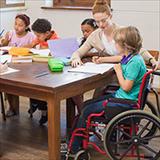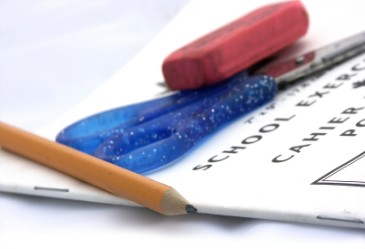

Five Homework Strategies for Teaching Students With Learning Disabilities
Many students with learning or reading disabilities find homework challenging. Here are five research-based strategies that teachers can use to help students.
On this page:
Strategy 1. give clear and appropriate assignments, strategy 2. make homework accommodations, strategy 3. teach study skills, strategy 4. use a homework calendar, strategy 5. ensure clear home/school communication.
Homework is one aspect of the general education curriculum that has been widely recognized as important to academic success. Teachers have long used homework to provide additional learning time, strengthen study and organizational skills, and in some respects, keep parents informed of their children’s progress.
Generally, when students with disabilities participate in the general education curriculum, they are expected to complete homework along with their peers. But, just as students with disabilities may need instructional accommodations in the classroom, they may also need homework accommodations.
Many students with disabilities find homework challenging, and teachers are frequently called upon to make accommodations for these students. What research supports this practice? This article describes five strategies that researchers have identified that help students with disabilities get the most from their homework. They include:
- Give clear and appropriate assignments
- Make homework accommodations
- Teach study skills
- Use a homework calendar
- Ensure clear home/school communication
Teachers need to take special care when assigning homework. If the homework assignment is too hard, is perceived as busy work, or takes too long to complete, students might tune out and resist doing it. Never send home any assignment that students cannot do. Homework should be an extension of what students have learned in class. To ensure that homework is clear and appropriate, consider the following tips from teachers for assigning homework:
- Make sure students and parents have information regarding the policy on missed and late assignments, extra credit, and available adaptations
- Establish a set homework routine at the beginning of the year
- Assign work that the students can do
- Assign homework in small units
- Explain the assignment clearly
- Write the assignment on the chalkboard and leave it there until the assignment is due
- Remind students of due dates periodically
- Coordinate with other teachers to prevent homework overload
Students concur with these tips. They add that teachers can:
- Establish a routine at the beginning of the year for how homework will be assigned
- Assign homework toward the beginning of class
- Relate homework to classwork or real life (and/or inform students how they will use the content of the homework in real life)
- Explain how to do the homework, provide examples and write directions on the chalkboard
- Have students begin the homework in class, check that they understand, and provide assistance as necessary
- Allow students to work together on homework
Make any necessary modifications to the homework assignment before sending it home. Identify practices that will be most helpful to individual students and have the potential to increase their involvement, understanding, and motivation to learn. The most common homework accommodations are to:
- Provide additional one-on-one assistance to students
- Monitor students’ homework more closely
- Allow alternative response formats (e.g., allow the student to audiotape an assignment rather than handwriting it)
- Adjust the length of the assignment
- Provide a peer tutor or assign the student to a study group
- Provide learning tools (e.g., calculators)
- Adjust evaluation standards
- Give fewer assignments
It is important to check out all accommodations with other teachers, students, and their families. If teachers, students, or families do not find homework accommodations palatable, they may not use them.
Both general and special education teachers consistently report that homework problems seem to be exacerbated by deficient basic study skills. Many students, particularly students with disabilities, need instruction in study and organizational skills. Here is a list of organizational strategies basic to homework:
- Identify a location for doing homework that is free of distractions
- Have all materials available and organized
- Allocate enough time to complete activities and keep on schedule
- Take good notes
- Develop a sequential plan for completing multi-task assignments
- Check assignments for accuracy and completion before turning them in
- Know how to get help when it is needed
- Turn in completed homework on time
Teachers can enhance homework completion and accuracy by providing classroom instruction in organizational skills. They should talk with parents about how to support the application of organizational skills at home.
Students with disabilities often need additional organizational support. Just as adults use calendars, schedulers, lists, and other devices to self-monitor activities, students can benefit from these tools as well. Students with disabilities can monitor their own homework using a planning calendar to keep track of homework assignments. Homework planners also can double as home-school communication tools if they include a space next to each assignment for messages from teachers and parents.
Here’s how one teacher used a homework planner to increase communication with students’ families and improve homework completion rates:
Students developed their own homework calendars. Each page in the calendar reflected one week. There was a space for students to write their homework assignments and a column for parent-teacher notes. The cover was a heavy card stock that children decorated. Students were expected to take their homework planners home each day and return them the next day to class.
In conjunction with the homework planner, students graphed their homework return and completion rates. Another strategy that is linked to homework completion and improved performance on classroom assessments. The teacher built a reward system for returning homework and the planners. On a self-monitoring chart in their planner, students recorded each time they completed and returned their homework assignment by:
- Coloring the square for the day green if homework was completed and returned
- Coloring the square for the day red if homework was not done
- Coloring one-half of the square yellow and one-half of the square red if homework was late
If students met the success criterion, they received a reward at the end of the week, such as 15 extra minutes of recess. The teacher found that more frequent rewards were needed for students with emotional and behavioral disabilities.
Homework accounts for one-fifth of the time that successful students invest in academic tasks, yet students complete homework in environments over which teachers have no control. Given the fact that many students experience learning difficulties, this creates a major dilemma. Teachers and parents of students with disabilities must communicate clearly and effectively with one another about homework policies, required practices, mutual expectations, student performance on homework, homework completion difficulties, and other homework-related concerns.
Recommended ways that teachers can improve communications with parents include:
- Encouraging students to keep assignment books
- Providing a list of suggestions on how parents might assist with homework. For example, ask parents to check with their children about homework daily
- Providing parents with frequent written communication about homework (e.g., progress reports, notes, letters, forms)
- Sharing information with other teachers regarding student strengths and needs and necessary accommodations
Ways that administrators can support teachers in improving communications include:
- Supplying teachers with the technology needed to aid communication (e.g., telephone answering systems, e-mail, homework hotlines)
- Providing incentives for teachers to participate in face-to-face meetings with parents (e.g., release time, compensation)
- Suggesting that the school district offer after school and/or peer tutoring sessions to give students extra help with homework
Liked it? Share it!
Bryan, T., Nelson, C., & Mathur, S. (1995). Homework: A survey of primary students in regular, resource, and self-contained special education classrooms. Learning Disabilities Research & Practice, 10(2), 85-90.
Bryan, T., & Sullivan-Burstein, K. (1997). Homework how-to's. TEACHING Exceptional Children, 29(6), 32-37.
Epstein, M., Munk, D., Bursuck, W., Polloway, E., & Jayanthi, M. (1999). Strategies for improving home-school communication about homework for students with disabilities. The Journal of Special Education, 33(3), 166-176.
Jayanthi, M., Bursuck, W., Epstein, M., & Polloway, E. (1997). Strategies for successful homework. TEACHING Exceptional Children, 30(1), 4-7.
Jayanthi, M., Sawyer, V., Nelson, J., Bursuck, W., & Epstein, M. (1995). Recommendations for homework-communication problems: From parents, classroom teachers, and special education teachers. Remedial and Special Education, 16(4), 212-225.
Klinger, J., & Vaughn, S. (1999). Students' perceptions of instruction in inclusion classrooms: Implications for students with learning disabilities. Exceptional Children, 66(1), 23-37.
Polloway, E., Bursuck, W., Jayanthi, M., Epstein, M., & Nelson, J. (1996). Treatment acceptability: Determining appropriate interventions within inclusive classrooms. Intervention In School and Clinic, 31(3), 133-144.
Adapted and reprinted with permission from the ERIC Clearinghouse on Disabilities and Gifted Education (opens in a new window) .
Visit our sister websites:
Reading rockets launching young readers (opens in a new window), start with a book read. explore. learn (opens in a new window), colorín colorado helping ells succeed (opens in a new window), adlit all about adolescent literacy (opens in a new window), reading universe all about teaching reading and writing (opens in a new window).
TIES TIPS Foundations of Inclusion
Tip #7: homework in the inclusive classroom.
Share this page
- Share this page on Facebook.
- Share this page on Twitter.
- Share this page on LinkedIn.
- Share this page on Pinterest.
- Share this page via email.
- Print this page.
Introduction
Homework is a universal experience for students and parents in classrooms around the country. Teachers assign homework for multiple reasons: a tool to reinforce learning, build fluency, extend student practice and thinking, prepare students for the upcoming lesson, and more. Homework is a key function of pre-teaching and re-teaching of content area skills so students with significant cognitive disabilities will greatly benefit from participation and expectations for homework as long as proper supports and adaptations are in place. Student learning is strengthened with multiple opportunities and repeated practice for newly taught skills. In addition, all students benefit from having background knowledge and schema activation prior to being introduced to new material. Homework is a great place to provide students with a foundation to tie learning to and can also help students firm up skills mastered at school. Within the context of an inclusion classroom, teachers often wonder what to do about homework for students with the most significant cognitive disabilities. The answer to this question about when and how to give homework cannot be answered until teachers decide what their main purpose or goal is for assigning homework for all their students. School and district policies may also influence the purpose and requirements for homework. Information and recommendations provided in this TIPS sheet specifically relate to the collaborative educational team process for how to make homework successful for students with the most significant cognitive disabilities in inclusive classrooms.
Homework for Students with the Most Significant Cognitive Disabilities
Teacher considerations:.
If teachers in the inclusive setting are assigning homework to students in their general education classrooms, then students with the most significant cognitive disabilities in those classrooms should be assigned homework with adaptations to fit their unique learning characteristics and needs. As is true for all students, teachers should consider their requirements for homework while setting high-expectations for all students, including students with the most significant cognitive disabilities. The general education teacher can work with the special education team (i.e. special education teachers, related service providers, paraprofessionals) to plan adaptations to homework. By presuming competence in all students, the bar is not lowered for students with the most significant cognitive disabilities and they are not excused from this important educational experience.
Parent considerations:
Parent involvement is key to successful homework for any student. Teams should involve all parents early in the school year in supporting their children with homework completion. For students with disabilities, teachers need to take the lead in establishing clear and frequent parent communication about homework policies, expectations, grading practices, and any areas where a student is having difficulties with homework (Jayanti et al., 1997). The need for clear and frequent teacher-parent communication is especially important for students with significant cognitive disabilities. Conversations about expectations for homework can start at the Individualized Education Program (IEP) meeting or can be part of parent-teacher conversations early in the school year. Parents of all types of students may have concerns about homework, including how it is graded, how long it takes to complete, and the cumulative volume of homework coming from multiple instructors. A meeting between the parents and teachers is a good starting point to allow parents to express any apprehensions they have about how to support their child in completing homework so the team can address this and find ways to help the parent. A face-to-face meeting is highly recommended, especially for students with the most significant cognitive disabilities. For example, if parents have concerns about having the time to assist their child with a significant cognitive disability with homework, this issue can be addressed in an IEP team meeting and possible solutions discussed (e.g., child receives homework help in special education resource room or after school program). The team can decide what will be most appropriate for each student. Without parent buy-in and assistance, it is likely that homework assigned may not be completed. However, when parents are included in the homework process, students can reap enormous benefits from the at-home assignments.
How Should the Homework be Differentiated for Students with the Most Significant Cognitive Disabilities
Before deciding how homework should be differentiated for students with the most significant cognitive disabilities, teachers must first decide what homework to assign for their whole class. It is important to match supports and accommodations students receive during instruction to the supports and accommodations provided for homework. For example, if a student has Velcro items to manipulate numbers on an equations board for solving math word problems during class, then these materials should be sent home with the student to maintain continuity between the two settings. Different approaches are also needed for adapting homework depending on the content of the homework assignment, the age of the student, and specific student needs.
Same homework as peers, with adaptations
Perhaps the simplest option for teachers is to assign the same homework to students with significant cognitive disabilities as to their peers (Stockall, 2017). Conversations about homework can often be heard at the lunch table. When students with significant cognitive disabilities are assigned the same homework, they also have an opportunity to engage in these conversations. More importantly, the content of the homework matches the content of instruction. It is important to remember that the adaptations the student needs in the classroom must also be applied to work at home (Hampshire et al, 2014).
Different homework from peers
Standards-based learning is an important part of education for a student with significant cognitive disabilities. Homework can provide students with significant cognitive disabilities an opportunity to practice foundational academic skills linked to the grade level content, making sure that the materials are still age appropriate (e.g., not giving an older child who needs foundational skills worksheets developed for kindergarteners). Teachers may choose to supplement grade-level work with assignments that address those bridging skills, such as basic arithmetic or sight word practice.
Differentiation for All
Homework differentiation may be needed in inclusive classrooms for many students, including students with and without disabilities. General education teachers can make accommodations and adaptations for students using principles of Universal Design for Learning (UDL). UDL involves incorporating multiple means of action and expression, engagement, and representation for teaching students. When incorporating UDL in homework, teachers can use any or all of the following UDL guidelines.
Multiple Means of Action and Expression
Teachers should use UDL to provide multiple means of action and expression for completing homework assignments. Teachers can do so by varying the methods for response and allowing multiple media tools to be used for completing homework. For example, a teacher might give the whole class three possible modes of expression for completing a homework assignment. Students could have the choice to respond to respond to a reading by: (a) making a video with a classmate (i.e., speaking); (b) writing a few paragraphs individually (i.e., writing); or (c) creating a Pinterest board with images summarizing the story and showing reactions to the text (i.e., use of visuals). For students with the most significant cognitive disabilities, they could choose a way to respond that works for them parallel to each option given to the class. For example, they could respond to a reading by: (a) creating a video with a classmate using their Alternative and Augmentative Communication (AAC) device to say some of their lines; (b) writing sentences using assistive technology device software; or (c) manipulating selected images that are relevant to the reading to create a permanent product such as a poster board. In these examples, differentiation is happening for everyone and it gives all students a way to show what they know, including students with the most significant cognitive disabilities. The educational team has to plan for the learner with the most significant cognitive disability to help them be successful with the response option they choose.
Multiple Means of Engagement
Teachers could also use UDL to provide multiple means of engagement by recruiting student interest in assignments by offering “individual choice and autonomy” or “optimizing relevance, value, and authenticity” for assignments (CAST, 2018). For example, instead of assigning math problems or spelling lists, consider instead a project-based approach where students apply the skills they have learned in class to real-life situations. For example, students could learn to add decimals making a budget, apply measurement skills when doing the laundry, or identify or read text in the community (Hampshire et al., 2014). Homework choice boards are another way to promote individual choice. This could involve giving students nine options for practicing their spelling words with choices such as writing the spelling words three times each, writing a short story using all of the spelling words, or typing the words into word processing software. This UDL guideline can be an option for all students to promote motivation for completing homework.
Multiple Means of Representation
Teachers could also use UDL to provide multiple means of representation for students prior to them completing homework assignments. For example, in a lesson highlighting students’ response to literature, a teacher could provide students with a choice between a hard copy book of Shakespeare’s MacBeth, or an e-book for their tablet with an optional read aloud feature. For students with significant cognitive disabilities the text might be simplified and shortened, with a summary added at the end and the written text supplemented with the ability to listen to the simplified story read aloud. The simplified text reduces the text complexity while focusing on the key events and characters needed to answer story comprehension questions. All students respond to MacBeth, but the way they take in the information about the text may vary.
Providing Feedback on Homework
After students turn in their homework, what next? Do we grade it for accuracy? For completion? Do we grade it at all? The answer will depend on the initial purpose of the homework assignment. Beyond grading, the teacher must decide how to give feedback to students in some way (e.g., giving stickers or stamps for good work, highlighting correct answers, providing written comments or audio recorded comments, engaging in a class discussion of common errors, etc.). Depending on the age of the student, it may be helpful for teachers to provide feedback that gives the student a chance to turn the mistakes into an opportunity for a learning experience. Feedback for students with the most significant cognitive disabilities can be more effective if delivered in an individualized manner with specific error correction.
Grading Homework for Accuracy
When homework is assigned to provide students with additional practice or to reinforce fluency, grading homework for accuracy may be an appropriate choice for students at some grade levels and in some situations. There are advantages and disadvantages to grading homework for accuracy. An advantage is that it is easy to see whether the student grasps the content. A disadvantage of grading for accuracy is that a score may reflect the help of their parents, making it difficult to determine what work the student completed independently.
Grading Homework for Completion
When homework is assigned as a way to prepare students for upcoming lessons or to extend student thinking, grading homework for completion may be the appropriate choice. Grading for completion may be particularly meaningful for students of a certain age, and for students with significant cognitive disabilities. For example, junior high students may do math homework at night to practice a concept, but may correct their own work in class the next day with the help of the teacher. The teacher simply checks off that the homework has been done. In this type of situation, homework is used to increase student independence and responsibility. By completing the work at home and returning it to school all students can begin to learn responsibility. If homework is graded only for completion, it is still important for teachers to review students’ errors and correct any misconceptions to prevent future errors.
Not Grading Homework
The final option is to simply not grade homework for any student in the class. Teachers may decide not to grade homework for a number of reasons. For example, a school may have a policy of assigning no homework for primary grade students other than requiring students to read for a certain number of minutes every night. If this is the standard for the general education classroom, then it is acceptable practice for students with the most significant cognitive disabilities as well. For some families, homework is a way to be engaged in their child’s education and can be a conversation piece when communicating with the teacher about their child’s progress. For these parents, they may be less concerned about the grade itself but more interested in seeing what topics their child is working on in school and watching to see what the child knows on their own.
If homework is part of the inclusive educational experience in the general education classroom, then students with the most significant cognitive disabilities should do homework too. Homework can serve many purposes, such as: reinforcing content learned in class, encouraging family engagement, allowing time to complete unfinished class work, and giving students a common topic for discussion with peers. Teachers should use the guiding principles of UDL to plan and design homework assignments that support the learning of all students. Educational teams should collaborate to figure out how to make homework meaningful and successful for all students with the most significant cognitive disabilities. Teachers should presume competence and not assume students with significant cognitive disabilities cannot do homework.
Bryan, T., & Burstein, K. (2004). Improving homework completion and academic performance: Lessons from special education. Theory Into Practice , 43 , 213–219. https://doi.org/10.1207/s15430421tip4303_7
CAST. (2018). The UDL guidelines . Retrieved from http://udlguidelines.cast.org/
Gill, B. P., & Schlossman, S. L. (2004). Villain or savior? The American discourse on homework, 1850-2003. Theory Into Practice , 43 , 174–181. https://doi.org/10.1207/s15430421tip4303_2
Hampshire, P. K., Butera, G. D., & Bellini, S. (2016). Self-management and parents as interventionists to improve homework independence in students with autism spectrum disorders. Preventing School Failure: Alternative Education for Children and Youth , 60 , 22–34. https://doi.org/10.1080/1045988X.2014.954515
Hampshire, P. K., Butera, G. D., & Hourcade, J. J. (2014). Homework plans: A tool for promoting independence. TEACHING Exceptional Children , 46 , 158–168. https://doi.org/10.1177/0040059914534615
Jayanthi, M., Bursuck, W., Epstein, M. H., & Polloway, E. A. (1997). Strategies for successful homework. TEACHING Exceptional Children , 30 , 4–7. https://doi.org/10.1177/004005999703000101
Stockall, N. (2017). Designing homework to mediate executive functioning deficits in students with disabilities. Intervention in School and Clinic , 53 , 3–11. https://doi.org/10.1177/1053451217692565
TIPS Series: Tip #7, November 2019
All rights reserved. Any or all portions of this document may be reproduced without prior permission, provided the source is cited as:
Clausen, A., Liu, K., Reyes, E. N., & Wakeman, S. (2019). Homework (TIPS Series: Tip #7) . Minneapolis, MN: University of Minnesota, TIES Center.
TIES Center is the national technical assistance center on inclusive practices and policies. Its purpose is to create sustainable changes in kindergarten-grade 8 school and district educational systems so that students with significant cognitive disabilities can fully engage in the same instructional and non-instructional activities as their general education peers, while being instructed in a way that meets individual learning needs. TIES Center is led by the National Center on Educational Outcomes (NCEO) at the Institute on Community Integration, University of Minnesota, and includes the following additional collaborating partners: Arizona Department of Education, CAST, University of Cincinnati, University of Kentucky, University of North Carolina – Charlotte, and University of North Carolina – Greensboro.
TIES Center is supported through a Cooperative Agreement (#H326Y170004) with the Research to Practice Division, Office of Special Education Programs, U.S. Department of Education. Opinions expressed do not necessarily reflect those of the U.S. Department of Education or Offices within it. Project Officer: Susan Weigert
TIES Center
University of Minnesota
Institute on Community Integration
2025 East River Parkway
Minneapolis, MN 55414
Phone: 612-626-1530
www.tiescenter.org
This document is available in alternate formats upon request.
The University of Minnesota is an equal opportunity employer and educator.

Icon(s) used on this page:
Homework Strategies for Students with Learning Disabilities
This guide outlines critical information and resources for parents and families of students with learning disabilities & neurodevelopmental disorders for supporting students with their homework assignments and setting them up for success later in life. Students with learning disabilities like Dyslexia and Dyscalculia as well as the neurodevelopmental disorder ADHD can benefit from the support and strategies not only with homework, but with their academic and professional careers as well.
Written by Sasha Blakeley
Effective Homework Strategies for Students with Learning Disabilities
Up to ten percent of American students under the age of eighteen may experience some form of learning disability, meaning that it is extremely important that these students have the support that they need to succeed in an educational environment. It is common for students with learning disabilities to find homework frustrating and challenging, which can put a strain on students' mental health, family relationships, and classroom dynamics. This guide aims to help students and their parents find effective strategies to make homework assignments easier and to help students learn, retain what they are learning, and build effective studying habits for the future.
What Are Learning Disabilities?
There are a number of learning disabilities that are recognized and diagnosable in children and in adults. This guide will focus on some of the most common children's learning disabilities, as they are the ones most likely to impact homework and students' school lives. Attention deficit hyperactivity disorder (ADHD), dyslexia, and dyscalculia are all relatively common among students and all of them can provide unique challenges. Other learning disabilities and related diagnoses like motor and coordination disorders, verbal and communication disorders, and executive dysfunction can also cause students to require different types of learning styles and support.
Homework and Learning Disabilities
Students with all types of learning disabilities often find homework frustrating and challenging. They might dread doing homework because of feelings of anxiety or inadequacy, or they might feel burned out after a day of school that has already required them to maintain significant focus over a long period of time. Homework might take them longer than it takes their peers, which can also be frustrating and demoralizing. It is worth noting that all students, whether or not they have a diagnosed learning disability, might struggle with homework, and the tips presented here can work for students without a learning disability or without a formal diagnosis as well as those who do have a diagnosis.
Why Do Teachers Assign Homework?
It is common for students to wonder why their teachers assign homework in the first place. While individuals and families may have their own feelings about how much homework is appropriate, homework does serve an important educational purpose. It can help reinforce what students learn during the day and can also help students develop self-motivation and time management skills. For students who already require extra support to complete their homework , it can be challenging to get everything done. It can be helpful to minimize students' extracurricular involvement if they are struggling with homework.
General Strategies for All Learning Disabilities
While each specific learning disability will align best with particular study strategies, there are some general tips that can help make the homework process easier for all students with learning disabilities. Before moving on to how to manage each individual learning disability, consider the following strategies for making a productive and manageable homework environment for students.
Clear Communication
Students with learning disabilities typically have needs that differ from the needs of their peers when it comes to completing school assignments. One of the best ways to ensure that those needs are being met is to create a culture of clear communication. This means clear, open-minded, and compassionate communication between students, parents, and teachers. It is important for everyone to be on the same page about expectations and guidelines for any given assignment. It is also important for parents and teachers to communicate with students about their needs, interests, and day-to-day challenges. It might also mean explaining to students why homework is important in real terms.
Creating a Routine
One of the most effective study strategies for all students, but especially for those with learning disabilities, is the creation of a routine. This means doing homework in the same place and at approximately the same time each day, schedule permitting. The exact nature of the routine will depend on a student's needs. It might also include building in time for breaks and play. Students have to focus for several hours while at school and can easily become overwhelmed if they have no time off in the afternoons. A routine can help students who are easily frustrated or made anxious by homework because it can help them know what to expect each day.
Disability Accommodations
Having a learning disability can be a challenging experience, but there are supports that can help. Students, teachers, and parents should ideally work together to put these supports in place and maintain them as needed. A teacher might be able to create an individualized education plan (IEP) for a student with a learning disability that could change homework expectations to better suit an individual's needs. There may be other school accommodations that can help, though what is best for each student will vary. Other options to consider might include getting a formal diagnosis and pursuing a variety of treatment options if any are available.
Collaboration Over Conflict
It can be easy to get into a pattern of conflict between student and parent when doing homework, especially when students find homework particularly frustrating and draining. It is important for students and their parents to feel that they are on the same side when it comes to education. Creating an environment that favors collaboration instead of conflict requires communication, a flexible mindset, and often a great deal of patience from all involved. It can be difficult to reframe homework as a collaborative effort, but it can be a very helpful goal for families to work toward.
Visual Learning Strategies
A lot of learning disabilities like dyslexia and neurodevelopmental disorders like ADHD can make it harder for students to handle large quantities of written information. As homework often requires a lot of reading and writing, this can present a challenge. It is widely recognized in educational theory that students often favor different learning styles, with some thriving on written material, others preferring visuals, and others again learning best with kinesthetic activities. Visual information can be especially helpful for students with learning disabilities, so it might be effective to incorporate flash cards, color-coding, and filling in charts or maps as part of the homework process whenever possible.
Homework and ADHD: Tips and Tricks
ADHD is often not specifically considered a learning disability, but it can impact other areas of students' lives and they way they learn. It can make it difficult for students to maintain focus on a particular task, especially if they do not find it interesting or rewarding. It can also impact an individual's impulse control. ADHD symptoms usually present in childhood. Students who have ADHD may need extra academic support to manage their homework and assignments.
Creating the Right Environment
Students with ADHD often struggle to focus on a single task, especially for a prolonged period of time. The right work environment can make focus easier to maintain. Ideally, it is helpful for students to have a reasonably private and quiet space to work, and it is best to avoid major distractions like cell phones while doing homework. However, some behaviors that students with ADHD might look like distraction while actually being helpful. Many students with ADHD benefit from a base level of mental stimulation while working, like listening to quiet music, having a toy to fidget with, or incorporating movement into learning.
How to Improve Focus and Retention
Because ADHD causes problems with prolonged focus, it can be helpful for students with ADHD to switch activities frequently to prevent them from getting bored and distracted. For students who struggle to retain information when it is presented in certain contexts, it might be helpful to consider using visual learning strategies, turning on subtitles on videos, and other forms of information reinforcement. Some students with ADHD find it difficult to get their thoughts down on paper in written form because their thought patterns are moving too quickly, in which case they might benefit from dictation or speech-to-text software when completing homework assignments.
Treatment and Support Options
It is possible to get medication as a form of ADHD treatment, and this might be effective for some students. However, it is not the right route for everyone and the choice to look into medication should always be a conversation between student, parent, and healthcare provider. Another form of support for ADHD is a shift in mindset: students with ADHD might develop ways of completing their work that are unusual but effective. Recognizing that the important thing is students' ability to learn, and not their adherence to a 'correct' way of doing things, can go a long way to finding effective learning strategies.
Homework and Dyslexia: Study Strategies
Dyslexia is a fairly common learning disability that impacts students' ability to read fluently. It can be diagnosed with high levels of accuracy in children as young as five, and without support, it can seriously impact students' experiences in school. Because reading is such a major aspect of schoolwork, dyslexia can be challenging to manage, but not impossible. With the right support and, ideally, a formal diagnosis, students can develop strong reading skills.
Break Reading Down
One of the simplest and most effective ways of helping students with dyslexia manage their homework is to break reading assignments down into manageable chunks so that they become less overwhelming. It can also be helpful to have students write down what they remember after reading a text to improve retention. If possible, consider setting aside specific time for reading assignments separate from other homework so that reading can get the focus that it needs. If parents are helping students with reading exercises, it can be helpful to quiz students on what they read, or to have students quiz parents to take some of the focus off them and make homework more collaborative.
Provide Encouraging Support
Dyslexia can be disheartening for students, and one of the best things that a parent can do is to provide encouragement and support for their children as they work through their homework. Facing homework, particularly reading, is often easier for students when they feel that their parents are rooting for them and want to help them succeed. Small rewards, bragging rights, or praise for completed assignments can all help students gradually dismantle their feelings of anxiety and inadequacy around reading. Even acknowledging the effort that students put into their work can go a long way.
Consider the Purpose of Each Assignment
Some homework assignments aim to test students' reading ability, while others have a different main purpose to which reading is incidental, like reinforcing a biology concept or practicing long division. For tasks where reading is the main goal, it is of course important for students with dyslexia to put their focus on reading and to reinforce their skills. For other tasks, however, it might reduce frustration and allow students to get through their work more quickly if parents read instructions to them, they hear information in video format, or they study with other students and focus on concepts over words.
Studying with Dyscalculia
Dyscalculia is a learning disability that makes it particularly difficult for students to understand mathematics and to process numerical equations. It may be as common as dyslexia, but it is not as widely understood. Unlike dyslexia, which can cause problems in any subjects where reading is required, dyscalculia is likely to impact only mathematics and some sciences. This means that any approach needs to be targeted for those subjects in particular.
Schedule Time for Math Homework
For students who have dyscalculia, it is important to set aside specific time to tackle math homework as it is likely the most challenging. Parents should communicate with their children about how they would like to structure this time. Would it be better to start with math and get it out of the way? Or would it be easier to finish other assignments first and tackle math last? Students might need a break between the end of the school day and the beginning of homework, or they might want to break up math homework among other things. Having some say in the matter can give students a sense of control.
Reduce Homework Stress
As with all learning disabilities, dyscalculia can cause stress when it comes to doing homework. Students might dread working on math assignments and might prefer not to complete them at all than to struggle with the material after school. Make sure students have a study environment that is soothing and consider mindfulness exercises to reduce anxiety. Mindfulness can help ground students in the present and can also help prevent catastrophic thinking and other forms of stress. Providing encouragement, taking breaks, and scheduling rewards or fun activities for after the homework is done can all help students approach math homework with a more positive attitude.
Consider Working with a Tutor
Because dyscalculia only impacts a specific skillset, rather than impacting students' academic performance more broadly, it might be helpful for students with dyscalculia to work with a tutor. Some tutors specialize in math or even in tutoring students with learning disabilities like dyscalculia. It is not uncommon for parents to feel out of their depth when trying to help with math assignments, especially if it has been years or decades since they learned how to solve a particular type of problem. Tutors can help fill in the gaps and can improve students' self-confidence and retention.
Homework and Other Learning Disabilities
All students who have learning disabilities will have different experiences, and not all students with a specific learning disability will have the same problems or needs when it comes to education. With the learning disabilities described above and the ones explored below, it is important to keep in mind that finding solutions to students' academic needs is a process that requires trial and error.
Motor and Coordination Disabilities
Motor and coordination disabilities are not, strictly speaking, learning disabilities. However, they often impact students' ability to complete their homework in a timely manner and they can be frustrating in many of the same ways as learning disabilities. Students who have motor and coordination disabilities may present a wide range of symptoms that might impact writing abilities and other skills necessary for homework. Some students might benefit from weighted pencils that make it easier to control one's writing, or else typing on a keyboard instead of writing by hand. Dictation software might also be helpful for these students, as well as mobility aids. It is important that students have access, whenever possible, to resources that can help them succeed.
Verbal and Writing Disabilities
Some disabilities impact students' ability to write or speak. Dysgraphia, for instance, is a term for a range of disabilities that impact writing. Any of these disabilities can make homework more frustrating, particularly as students get older and writing becomes a more prevalent part of homework. As with ADHD, one of the best ways to approach these disabilities is to think outside the box and to let go of the idea that students must complete tasks a certain way. It is perfectly acceptable if students need to use assistive technologies or find non-verbal ways of responding to prompts, as long as they are still learning and engaging with material.
Executive Dysfunction
Executive dysfunction is not a diagnosis of its own, but rather a set of symptoms usually but not always associated with ADHD. It can cause individuals to struggle with time management and with transitioning from one task to another. It is not the same thing as procrastination, though procrastination is certainly also an issue that can make homework more difficult. Managing executive dysfunction can mean setting alarms for switching tasks, being accountable to others, and sticking to a routine each day. It is a difficult issue to manage and there is no easy solution, but it is something that tends to improve with practice.
Students with Learning Disabilities: High School, College, and Beyond
Learning disabilities do not necessarily disappear as students get older, and many students will need to learn to manage their learning disabilities throughout their secondary and post-secondary education. Although this can be challenging, it is also something that students can learn to do with practice and patience. The following study tips for college and high school students can reduce stress, improve students' grades, and make learning disabilities a part of the learning process instead of a major barrier to success.
Effective Time Management
Time management is one of the most important sets of skills that students can learn, particularly before going to college. Having good time management skills can help students dedicate more time to subjects that they struggle with, especially because of a learning disability. Students should practice making comprehensive lists of all homework and deadlines, setting alarms to begin or change tasks, and taking breaks to reset one's brain. There is no universal set of time management skills that works for everyone. Instead, it is important for students to be introspective and to experiment with different strategies.
Where to Find Support
It is important for students at any educational level to know that if they need help, there are ways for them to reach out to others. This can mean speaking to parents, teachers, guidance counselors, professors, TAs, and student disability accommodations offices at colleges and high schools. Many schools will offer testing accommodations that provide students with extra time on exams and assignments if they have a demonstrable need. If necessary, seeking support can also mean working with therapists, doctors, and other healthcare providers to get the necessary support for a learning disability. These services are designed to help students thrive.
Building Positive Study Habits
Positive study habits can take many forms. They can include positive self-talk, changing one's approach if things are not working, and developing and maintaining good communication skills. It is also important to build good self-care habits, like getting enough sleep, eating healthy food, and exercising. One of the best ways to maintain habits is to start a daily routine and to start with one or two habits at a time to create gradual but lasting change.
Because differences are our greatest strength
Homework challenges and strategies

By Amanda Morin
Expert reviewed by Jim Rein, MA

At a glance
Kids can struggle with homework for lots of reasons.
A common challenge is rushing through assignments.
Once you understand a homework challenge, it’s easier to find solutions.
Most kids struggle with homework from time to time. But kids who learn and think differently may struggle more than others. Understanding the homework challenges your child faces can help you reduce stress and avoid battles.
Here are some common homework challenges and tips to help.
The challenge: Rushing through homework
Kids with learning difficulties may rush because they’re trying to get through what’s hard for them as fast as possible. For kids with ADHD, trouble with focus and working memory may be the cause.
Rushing through homework can lead to messy or incorrect homework. It can also lead to kids missing key parts of the assignment. One thing to try is having your child do the easiest assignments first and then move to harder ones.
Get more tips for helping grade-schoolers and middle-schoolers slow down on homework.
The challenge: Taking notes
Note-taking isn’t an easy skill for some kids. They may struggle with the mechanical parts of writing or with organizing ideas on a page. Kids may also find it hard to read text and take notes at the same time.
Using the outline method may help. It divides notes into main ideas, subtopics, and details.
Explore different note-taking strategies .
The challenge: Managing time and staying organized
Some kids struggle with keeping track of time and making a plan for getting all of their work done. That’s especially true of kids who have trouble with executive function.
Try creating a homework schedule and set a specific time and place for your child to get homework done. Use a timer to help your child stay on track and get a better sense of time.
Learn about trouble with planning .
The challenge: Studying effectively
Many kids need to be taught how to study effectively. But some may need concrete strategies.
One thing to try is creating a checklist of all the steps that go into studying. Have your child mark off each one. Lists can help kids monitor their work.
Explore more study strategies for grade-schoolers and teens .
The challenge: Recalling information
Some kids have trouble holding on to information so they can use it later. (This skill is called working memory. ) They may study for hours but remember nothing the next day. But there are different types of memory.
If your child has trouble with verbal memory, try using visual study aids like graphs, maps, or drawings.
Practice “muscle memory” exercises to help kids with working memory.
The challenge: Learning independently
It’s important for kids to learn how to do homework without help. Using a homework contract can help your child set realistic goals. Encourage “thinking out loud.”
Get tips for helping grade-schoolers do schoolwork on their own.
Sometimes, homework challenges don’t go away despite your best efforts. Look for signs that kids may have too much homework . And learn how to talk with teachers about concerns .
Key takeaways
Some kids have a hard time doing schoolwork on their own.
It can help to tailor homework strategies to a child’s specific challenges and strengths.
Sometimes, there’s too much homework for a child to handle. Talk to the teacher.

Explore related topics
- Trying to Conceive
- Signs & Symptoms
- Pregnancy Tests
- Fertility Testing
- Fertility Treatment
- Weeks & Trimesters
- Staying Healthy
- Preparing for Baby
- Complications & Concerns
- Pregnancy Loss
- Breastfeeding
- School-Aged Kids
- Raising Kids
- Personal Stories
- Everyday Wellness
- Safety & First Aid
- Immunizations
- Food & Nutrition
- Active Play
- Pregnancy Products
- Nursery & Sleep Products
- Nursing & Feeding Products
- Clothing & Accessories
- Toys & Gifts
- Ovulation Calculator
- Pregnancy Due Date Calculator
- How to Talk About Postpartum Depression
- Editorial Process
- Meet Our Review Board
How to Teach a Child With Learning Disabilities
Learning disabilities are surprisingly common. They are a result of differences in brain structure but do not relate to intelligence, behavior, or focus. In short, they are differences that make it difficult to succeed in a typical American school, though they may have relatively little impact on tasks of daily living.
What Are Learning Disabilities?
According to the website LDOnline, the most common learning disabilities include:
- Auditory and visual processing disorders : "Sensory disabilities in which a person has difficulty understanding language despite normal hearing and vision."
- Dyscalculia : A mathematical disability
- Dysgraphia : A writing disability
- Dyslexia : A reading disorder
- Nonverbal learning disabilities : A neurological disorder that causes problems with "visual-spatial, intuitive, organizational, evaluative and holistic processing functions."
Learning disabilities affect one in five American children.
Often, students with learning disabilities will have an Individualized Educational Program or 504 Plan which details teaching accommodations. These are usually similar to the general suggestions offered below.
Helping Children Succeed in School
Most instruction at home or in school can be adapted to accommodate the needs of students with learning disabilities such as dyslexia or other learning problems. These strategies can be used to modify instruction in most subject areas to improve students' comprehension of tasks and the quality of their work.
These approaches, incidentally, can also be helpful for most students who prefer a clear, structured educational program.
- Ask for a scoring guide . Teachers should develop a scoring guide, share it with students, and provide models of examples of each level of performance.
- Never use a student's work as a public example of poor work for the class to see. This is humiliation, and it has no place in any classroom or home.
- Clearly outline the instructions . Lessons should include specific, step-by-step instructions that are explicitly stated by the teacher and modeled for the student.
- Create models of quality work that students can see and analyze . Include both spoken and written explanations of how the work fulfills academic expectations.
- Define classroom expectations for work and behavior . Post them, and use them as a basis of all interactions and class projects. Making your requirements a part of the classroom or homework routine will help the student meet expectations.
- Have the student repeat back the instructions . Correct any miscommunication before he begins the actual work. Check back on the student as he works to ensure he is doing the work correctly. Prompt him as necessary to ensure that he corrects any mistakes before he finishes.
- Set the stage for learning . Tell children why the material is important, what the learning goals are, and what the expectations are for quality performance.
- Use graphic organizers . Help students understand the relationships between ideas.
- Use specific language . Instead of saying, "do quality work," state the specific expectations. For instance, if the teacher is grading based on correct punctuation, spelling, and the inclusion of specific points, communicate with the teacher and your child to work on meeting these expectations.
Learning Disabilities Association of America. Types of Learning Disabilities .
LDOnline. What is a Learning Disability ?
By Ann Logsdon Ann Logsdon is a school psychologist specializing in helping parents and teachers support students with a range of educational and developmental disabilities.
Click To Get Help Now! Contact Us

- Math Program
- Reading Program
- Tutoring Options
- Scholarships
- About Dyslexia
For Parents
- For Teachers
Homework Strategies for Students with Learning Disabilities
Up to ten percent of American students under the age of eighteen may experience some form of learning disability, meaning that it is extremely important that these students have the support that they need to succeed in an educational environment. It is common for students with learning disabilities to find homework frustrating and challenging, which can put a strain on students’ mental health, family relationships, and classroom dynamics. This guide aims to help students and their parents find effective strategies to make homework assignments easier and to help students learn, retain what they are learning, and build effective studying habits for the future. Source: homework.study.com
Overcome Reading and Math Challenges with One-on-One Dyslexia Tutoring Today

Thinking and Learning

Principle 1: Students’ beliefs or perceptions about intelligence and ability affect their cognitive functioning and learning
Students who believe that intelligence and ability can be enhanced tend to perform better on a variety of tasks and in problem-solving situations.
Sample tips for teachers
Teachers can foster student beliefs that their intelligence and ability can be developed through effort and by applying different strategies:
- Positive messages about people with disabilities (or other demographic groups to which students belong) and self-affirming activities, may help counteract students’ negative self-perceptions due to stereotypes about factors such as their race or disability status, and may in turn increase academic performance.
- Make sure the content of praise is tied to effort or successful strategies and not ability.
- Unsolicited offers of help by a teacher, especially when other students do not receive help, and sympathetic affect from a teacher following student failure can be interpreted by students as indirect and subtle cues about low ability.
Principle 2: What students already know affects their learning
Students come to classrooms with preconceived knowledge based on their everyday experiences, social interactions, intuitions, and what they have been taught in other settings and in the past. Accordingly, learning consists of either adding to existing knowledge or transforming or revising knowledge.
Teachers can be instrumental in achieving both growth and change in a targeted manner:
- Provide accessible instructional materials (e.g., audio books, assistive technology to support reading like screen readers) for students with disabilities that impact language and reading print.
- When considering why students were unsuccessful, teachers should encourage students to reflect on what worked and how to advocate for accommodations and tools they need to succeed (e.g., text to speech or tactile drawings). The reflection should focus on how to change their learning environment rather than negative attributes about the student.
- To identify misconceptions held by the student, teachers can engage their students in activities that tap into their curiosity and increase their interest in the topic by asking questions, defining, summarizing, synthesizing, applying concepts, and participating in hands-on activities.
Principle 3: Students’ cognitive development and learning are not limited by general stages of development
Student reasoning is not limited by an age or a grade level. Students are capable of higher-level thinking and behavior when (a) there is some competency for knowledge in the domain, (b) they already have some familiarity or expertise with a knowledge domain, (c) they interact with more capable others or challenging materials, and (d) in contexts with which they are familiar through experience.
In designing instruction, teachers can facilitate the advancement of student reasoning in the following ways:
- Encourage students’ reasoning in familiar areas—that is, in domains and contexts in which students already have substantial knowledge.
- Use groupings whereby students are placed in mixed-ability groups to allow for interaction with higher-level thinkers in learning and problem solving.
- Teachers can gain information from family members that might aid in understanding students’ out-of-the classroom functioning and learning.
Principle 4: Learning is based on context, so generalizing learning to new contexts is not spontaneous but instead needs to be facilitated
Learning occurs in context. Contexts can consist of subject matter domains (e.g., science), specific tasks/problems (e.g., a textbook problem to solve), social interactions (e.g., caretaking routines between a parent and child), and situational/physical settings (e.g., home, classrooms, museums, labs). Hence, for learning to be more effective or powerful, it needs to generalize to new contexts and situations.
Teachers can support students’ transfer of knowledge and skills across contexts—from highly similar to highly dissimilar. This is best done by the following:
- Consult with the individualized education program (IEP) team, parents, and caregivers for appropriate goal setting, breakdown of learning steps, and strategies over time that work before introducing new methodologies and concepts.
- Build on strengths that students bring to a learning situation, thereby making connections between students’ current knowledge and skills and the teachers’ learning goals.
- Acknowledge that each student with some disabilities might need sensory input and support to be successful in learning about multiple contexts.
Principle 5: Acquiring long-term knowledge and skill is largely dependent on practice
Practice is key to the transfer of information from short-term to long-term memory in at least five ways. Evidence demonstrates (a) increased likelihood that learning will be long-term and retrievable, (b) enhanced student ability to apply elements of basic knowledge automatically and without reflection, (c) skills that become automatic free up students’ cognitive resources for learning more challenging tasks, (d) increased transfer of practiced skills to new and more complex problems, and (e) gains often bring about motivation for more learning.
Effective methods of implementing practice in the classroom include:
- Enhance the value of testing, or any kind of practice exercise, by conducting them at spaced intervals and giving them frequently.
- Design tasks with students’ existing knowledge in mind.
- Ensure student learning is reinforced during extended school breaks.
- Provide family members with concrete examples and activities to set test-taking expectations and to practice at home.
Principle 6: Clear, explanatory, and timely feedback to students is important for learning
Learning can be increased when students receive regular, specific, explanatory, and timely feedback on their work. Feedback is most effective for students with disabilities when it describes the gap between their current performance and the goal for their desired performance, and provides cues for how to close that gap.
- Feedback can be accompanied by relevant learning goals that tell students what they are (or are not) understanding and the strength of their performance. It is ultimately important that students with disabilities participate in and learn to set personal goals for their learning.
- It is useful to provide students with disabilities with guided practice in strategies that they can use to improve their work and reach their goals.
- Feedback is even more effective when it describes what students can do in the future when they achieve those goals.
- When students are learning a new task or struggling with an existing one, frequent praise following small degrees of improvement is very important, and when progress is evident, encouragement to persist can matter a great deal.
Principle 7: Students’ self-regulation assists learning, and self-regulatory skills can be taught
Self-regulatory (or executive function) skills, including attention, organization, self-control, planning, and memory strategies, enable students to learn efficiently and effectively. This principle is particularly important for teachers of special education students because many the diagnostic criteria for common disabilities include self-regulatory skills (e.g., inattention and impulse control are criteria for attention-deficit/hyperactivity disorder (ADHD)). These skills allow students to arrive prepared, follow instructions, attend to the teacher, and ignore distractions.
The classroom environment itself can also be organized to enhance self-regulation.
- Break down tasks into smaller “chunks” and clearly spell out the criteria for successful task performance.
- Help students identify and evaluate short- and long-term goals for performance or consequences to their decisions.
- Use cues to alert students that important information will follow, especially when introducing a new concept.
- Gain additional strategies from family members of what works in the home environment that might be used within the school setting.
Principle 8: Student creativity can be fostered
Contrary to the conventional wisdom that creativity is a stable trait (you either have it or you don’t), creative thinking can be enhanced and nurtured in all students, making it an important outcome of the learning process for students and educators. Moreover, creative approaches to teaching can inspire enthusiasm and joy in the learning process by increasing student engagement and modeling real-world applications of knowledge across domains.
A variety of strategies are available for teachers to establish classroom environments that are conducive to creative thinking in students, including:
- Encourage openness to diverse perspectives during discussions, reinforcing that perspectives from all students are clearly valued and welcomed in the classroom.
- Orchestrate special classroom activities where rules are allowed to be broken or students can generate their own rules. Such activities might give students opportunities to experience creativity and teach them how to cope with novel and unexpected challenges.
- Be aware that highly creative students are often seen as disruptive; however, student enthusiasm can be channeled into solving real-world problems or taking leadership roles on certain tasks.
- Model creativity. Teachers are powerful models, and as such, they should share with students their own creativity—including the use of multiple strategies to solve problems across various aspects of their lives.
For further explanation and additional tips for teachers, download the full report .

Thinking and Learning Principles 1-8

Motivation Principles 9-12

Social-Emotional Learning Principles 13-15

Classroom Management Principles 16-17

Assessment Principles 18-20
Top 20 Principles for Students with Disabilities
All Top 20 Principles
Contact Education

NEW Parenting Course: Transform Your Parenting Skills with Holistic Positive Parenting™
Homework Strategies for Students with Learning Disabilities

RELATED: Download Our Free Homework Charts !
Clear Communication with the Teacher
It’s important that assigned homework is clear and appropriate for the student. If the homework is too difficult or too easy, it can cause challenges at home. If the homework assignment is unclear, then it makes things frustrating for children and adults. It’s important for parents and teachers to work together to monitor homework assignments and their completion.
Children in general need structured time for homework. The same is true for children with learning disabilities. It’s important that they know what’s expected of them and that they have a designated study time. Try to make sure that a parent or a tutor is available during the study time to monitor the child and to step in and help if necessary.
Organization
One of the challenges for many children with learning disabilities is getting and staying organized. They may struggle to create systems. Checklists, homework notebooks, and other systems can help a child write down the necessary information for each assignment. They need to learn to document the details as well as when the assignment is due. If you have a designated homework area, consider creating an environment that is organized to support your learner. It might include learning tools like calculators, pencils, and file organizers color coded for each subject.
Teach Self-Monitoring
Your child isn’t going to always have someone available to create systems for them or hold them accountable. They need to learn to manage these responsibilities themselves. Create an accountability chart that helps them stay on track. The chart might give stars for days with completed homework, blank marks for days that homework was not completed, and a checkmark if the homework was done but late. This type of system can also alert parents to potential issues. For example, if you notice that your child has had late homework three days in a row, you know that something’s not working.
Make It Fun
When possible, make homework something that your child doesn’t dread. Provide snacks, allow them to listen to music (if it isn’t distracting), and let them take breaks. If your child has a positive attitude about homework, it can reduce their resistance and potential struggle.
The most important homework strategy for parents with children who have learning disabilities is to have an open line of communication with the child’s teachers. When parents and teachers work together to create appropriate homework, children benefit.
About The Author

Pamela Myers, BSEd
Child development books.
Our recommendations for books on child development for parents.
The Well Balanced Family
How to disconnect to reconnect so you can grow and have fun together.

We don't sell your information.
The information on this website is solely for informational purposes. IT IS NOT INTENDED TO PROVIDE MEDICAL ADVICE. Neither Parenting Today, LLC nor Dr. Myers nor any of the editors, columnists or authors take responsibility for any possible consequences from any action taken which results from reading or following the information contained in this information. The publication of this information does not constitute the practice of medicine or psychology, and this information does not replace the advice of your physician or mental health care provider. Before undertaking any course of treatment, the reader must seek the advice of their physician or other healthcare provider.
Copyright © 1999-2024 Parenting Today, LLC - All Rights Reserved

It’s Time to Rethink Homework for Students With Disabilities
Editor's Note
If you’re looking for creative inspiration, check out the Daily Inspirations group on The Mighty.
I’m just going to say it: Homework is a thorn in the side of most parents raising children with disabilities. In case you haven’t experienced it, let me explain:
Other relevant stories: • What Does Meth Do to Someone Who Has ADHD? • Difference Between ADHD and Autism • ADHD Iceberg • What is ADHD?
You wake up in the morning ready to implement your well-crafted morning routine that includes the most efficient way to get your child clothed, fed, packed up, and in the car with the fewest moments of frustration, tears and conflict with siblings. Because school is hard for your child, making it through the morning routine and into the school building is your child’s first triumph of the day. During that school day, your child is faced with challenging tasks. There will be spoken language to process , pencils to grip, a body to keep still, transitions to initiate, social interactions to understand, and non-preferred academic work to complete.
Your child will probably be exhausted when they get to you at pick-up. This is understandable. They have just “left it all on the field” in the classroom. They need time to recover, to engage in preferred play, and to rest and reconnect with you. But before they can rest, some days your child will have a therapy appointment to work on emotional regulation, language skills, motor skills, or sensory needs.
What happens when they get home? There is more to do. There is homework. Your child does not yet work independently so you are now their teacher, except you don’t have a degree in special education. Not only are you trying to help your exhausted child, you are also trying to cook dinner, pick up a sibling from dance, and return a work call because you left work early to be home with your child after school. You are exhausted, too. Does this sound familiar?
So, why are we giving homework to our students with disabilities? There are many costs, but are there any benefits? I think there can be — if we first determine a student’s readiness for homework and we then plan to support them. Here’s how.
The Need for Play
Some schools in America have begun doing away with assigning homework before fifth grade due to the developmental need for play and movement. Elementary-aged children are still learning through play and need time for unstructured play or structured arts, music, or sports time after school. A school day’s-worth of academic learning is enough at this age and young children need time outside to move their bodies, free time to recover from the demands placed on them, and quiet time to be alone with their thoughts or to connect with their family.
Prior to being developmentally ready for independent work, I believe the only homework that should be assigned is nightly reading with a parent, adult family member, or older sibling. Reading with someone builds connection, imagination, and social comprehension skills that create feelings of security and confidence, which both lead to a love of learning.
Why Children With Disabilities May Not Be Homework-Ready Alongside Their Same-Age Peers
For children with anxiety surrounding academic work due to a learning disability, attention difficulties, or sensory overload, they are often exhausted from the school day. A child’s optimal time for focusing and learning may not be 4:00-6:00 pm, much less 7:00-9:00 pm. If a child is fighting or refusing to do homework, there is a reason. As parents and educators, we must pay attention to these patterns of emotional distress, figure out the cost and benefit of homework, and collaborate with teachers on a plan for the most supportive learning experience, either in the classroom or at home.
When Are Students Ready for Homework? Focus First on Executive Functioning Skills
The benefit of homework is in the extra practice that leads to the mastery of a concept, either academic or organizational, and higher confidence of that skill when the student returns to school the following day. While the benefit of homework in the elementary years is often to master reading, writing, and math skills, homework for fifth graders and beyond should focus on executive functioning. In order to complete homework independently, students must have solid executive functioning skills .
Our executive functioning encompasses our planning, organizing, initiating, attending, shifting focus, and execution of tasks. We need these skills to turn our ideas into plans and our plans into actions. Our executive functioning, located in the frontal lobe of our brain, does not fully develop until our mid-20s . When we assign homework to pre-teens and teenagers without also teaching them how to organize and execute the work, we are doing them a huge disservice.
A Warning About Middle School
Most children shift from needing a parent to sit down with them to complete homework to completing it on their own sometime between third and fifth grades. However, children with learning disabilities , ADHD , anxiety , and/or autism spectrum disorders may not be able to work independently for several more years, which can lead into their middle school years.
When the load of middle school homework increases before a child’s ability to work independently, we are met with frustration from the child and their parents. Many parents have found it helpful to ask your child’s IEP team for modified homework where teachers can assign the amount of homework they know the student is capable of completing independently. More challenging tasks that could help the student grow, such as long-term projects and reports, can be assigned with the student’s need for support in mind, such as shorter deadlines on smaller portions of a project to teach time management.
Teach a Work/Life Balance
After graduate school, I remember the relief I felt when I didn’t have homework anymore. Now, I go out of my way to plan healthy boundaries in my own life so I don’t bring work home. Shouldn’t we be teaching children how to have healthy boundaries around work and play? Shouldn’t we be teaching them how to balance work completion and time with family and friends? All children would benefit from these lessons; however, our differently-wired children are our most vulnerable to this work/life balance and their discomfort is demanding we change the system for them.
When homework is assigned in the same way for everyone, we ignore the fact that each student has a different amount of gas in their tank. Some have fuel for homework at the end of the day and some just do not. When we ask students to keep working after school when their tank is on empty, we likely damage their love of learning and fill them with dread for tomorrow.
Recharge your soul
Join the Daily Inspirations group on The Mighty to spark your creativity. Browse through quotes, song lyrics, art and more, or share what inspires you!
Getty image by Chatchai Limjareon.
Dr. Emily King is a licensed psychologist in private practice in Raleigh, North Carolina. She received her Ph.D. in School Psychology from UNC-Chapel Hill and previously provided school-based mental health services in Houston, Texas. Dr. King has worked with children and families for over 15 years and specializes in Autism, ADHD, and anxiety. She is also the mother of two energetic boys who are her best teachers. Follow Dr. King's blog "Parenting...on your own path" at www.dremilyking.com/blog or on Facebook @dremilyking and Twitter @emilywkingphd.
- DOI: 10.1177/002221949402700802
- Corpus ID: 9581790
Homework for Students with Learning Disabilities
- H. Cooper , B. Nye
- Published in Journal of Learning… 1 October 1994
Tables from this paper

76 Citations
Homework for students with disabilities, increasing the homework completion rates of students with mild disabilities.
- Highly Influenced
Homework can be challenging for students with learning disabilities
Students with learning disabilities: homework problems and promising practices, solving communication problems about homework: recommendations of special education teachers, teacher-selected strategies for improving homework completion, homework-related communication problems, homework practices of students with and without learning disabilities, increasing the effectiveness of homework for all learners in the inclusive classroom., a comparison of the homework problems of secondary school students with behavior disorders and nondisabled peers, 36 references, the effects of daily homework assignments on the acquisition of basic skills by students with learning disabilities.
- Highly Influential
Homework: a neglected research area
An examination of the homework practices of teachers of students with learning disabilities, the effects of a structured home plan on the home and school behaviors of gifted learning‐disabled students with deficits in organizational skills, increasing organizational skills and homework productivity with ninth grade emotionally handicapped and regular students., academic behavior and grades of mainstreamed students with mild disabilities, impact of unsupervised parent tutors on word recognition skills, homework: a review of special education practices in the southwest., the necessary restructuring of special and regular education, the effects of homework on learning: a quantitative synthesis, related papers.
Showing 1 through 3 of 0 Related Papers
Homework Strategies for Children with Learning Disabilities
By: lindsay hutton.

Team Effort

Five Minute Fun Break

Homework Completion Chart

Share the Reading

Scented Strategy

Homework Box

Book Report Helper

Homework Behavior Plan
Fe most popular slideshow.

An Age-by-Age Guide to Teaching Kids About "The Birds & The Bees"

12 Simple Developmental Activities to Play with Your Baby

Top 10 Graduation Gifts
8 printable thank-you cards for teacher appreciation week, join the family.
Your partner in parenting from baby name inspiration to college planning.
An official website of the United States government
The .gov means it’s official. Federal government websites often end in .gov or .mil. Before sharing sensitive information, make sure you’re on a federal government site.
The site is secure. The https:// ensures that you are connecting to the official website and that any information you provide is encrypted and transmitted securely.
- Publications
- Account settings
- My Bibliography
- Collections
- Citation manager
Save citation to file
Email citation, add to collections.
- Create a new collection
- Add to an existing collection
Add to My Bibliography
Your saved search, create a file for external citation management software, your rss feed.
- Search in PubMed
- Search in NLM Catalog
- Add to Search
Homework and students with learning disabilities and behavior disorders: a practical, parent-based approach
Affiliation.
- 1 Department of Educational Psychology, University of Utah, Salt Lake City, 84112.
- PMID: 7806956
- DOI: 10.1177/002221949402700901
This article provides a limited review of the effects of homework on students with disabilities, the essentials of effective homework programs, and variables that affect home-school partnerships. The emphasis is on students with learning disabilities and behavior disorders who are at risk for academic failure and poor school adjustment. The authors introduce the University of Utah Homework Partners series, which highlights three homework packages: a cooperative learning teams-based approach for classrooms, a package to train parents to be positive academic tutors for their children, and a systematic program to train parents in effective homework practices. The latter package is the major focus of this article because it emphasizes home-school partnerships for students with disabilities. Sanity Savers for Parents: Tips for Tackling Homework is a training program that teaches parents how to assess, design, and troubleshoot an effective in-home homework program for their child. The overall emphasis of this program is on practical interventions that are positive and motivating and include a home-to-school link to maximize the generalization of effects for students with learning and behavior disabilities.
PubMed Disclaimer
Similar articles
- Practical recommendations for using homework with students with learning disabilities. Patton JR. Patton JR. J Learn Disabil. 1994 Nov;27(9):570-8. doi: 10.1177/002221949402700904. J Learn Disabil. 1994. PMID: 7806959
- Homework practices of students with and without learning disabilities: a comparison. Gajria M, Salend SJ. Gajria M, et al. J Learn Disabil. 1995 May;28(5):291-6. doi: 10.1177/002221949502800504. J Learn Disabil. 1995. PMID: 7775848
- Making homework work at home: the parent's perspective. Kay PJ, Fitzgerald M, Paradee C, Mellencamp A. Kay PJ, et al. J Learn Disabil. 1994 Nov;27(9):550-61. doi: 10.1177/002221949402700902. J Learn Disabil. 1994. PMID: 7806957
- Homework for students with learning disabilities: the implications of research for policy and practice. Cooper H, Nye B. Cooper H, et al. J Learn Disabil. 1994 Oct;27(8):470-9. doi: 10.1177/002221949402700802. J Learn Disabil. 1994. PMID: 7989851 Review.
- Learning disabilities. Lyon GR. Lyon GR. Future Child. 1996 Spring;6(1):54-76. Future Child. 1996. PMID: 8689262 Review.
Publication types
- Search in MeSH
Related information
Linkout - more resources, full text sources.
- Genetic Alliance
- MedlinePlus Health Information

- Citation Manager
NCBI Literature Resources
MeSH PMC Bookshelf Disclaimer
The PubMed wordmark and PubMed logo are registered trademarks of the U.S. Department of Health and Human Services (HHS). Unauthorized use of these marks is strictly prohibited.
How One School Fosters Belonging for Students With Disabilities

- Share article
Fostering a sense of belonging in school takes a lot of intentional effort, especially when it comes to students with disabilities, who have traditionally been excluded from many mainstream classes and activities.
That’s according to a principal who has dedicated her career to that cause.
Cathi Davis, principal of Ruby Bridges Elementary School in Woodinville, Wash. , near Seattle which opened in 2020, runs a school that is designed so students with disabilities spend nearly all of their time in general education classes learning alongside their peers, rather than being pulled out for specialized instruction.

It’s one of 16 schools in Washington state that partner with the Haring Center for Inclusive Education at the University of Washington with the goal of demonstrating that all students benefit when schools are intentionally designed with the needs of students with disabilities at the forefront.
“We did a lot of planning to think about how we could really facilitate an opportunity for students to see themselves throughout the school, and to know that we thought of them in the design of the school,” Davis said during a webinar hosted by Education Week on May 23. “Really, that was less about architecture—that wasn’t about paint, that wasn’t about the parking lot. It was about our mindsets and our heart work that we were doing as a staff to think about how belonging could come off the page for each and every student.”
The approach diverges from the traditional K-12 education model through which students with Individualized Education Programs, or IEPs, are pulled out of classes with their peers into separate settings where they receive individualized or small-group instruction.
Ruby Bridges’ approach helps students with disabilities form relationships with their classmates and others in their school, and helps general education students build empathy and compassion. Several studies over the years examining these more inclusive practices have found either neutral or positive effects on all students’ performance in core subjects like math and reading.
“We know that all students benefit from that general education access,” Davis said. “We know learning’s not linear, and I think more and more we understand that our students are more engaged when learning is tailored to fit their needs and their strengths.”

In Ruby Bridges classrooms, all students have access to supports traditionally outlined in students’ IEPs or 504 plans, like the ability to take breaks when feeling overwhelmed, or the opportunity to learn in a small group with the teacher, while others might work independently on a tablet with headphones on.
During one recent phonics lesson she was observing, Davis recalled one student who was participating in a group lesson, but was bouncing on a trampoline at the same time to help regulate their senses.
“It’s that sense of truly being welcomed into a community, not like, ‘You get to be here, too, but over there,’” Davis said. "…But rather, we are all being together and kind of framing our identity around what that means for us.”
One of the keys to how Ruby Bridges works is its staffing model, which emphasizes collaboration.
For example, rather than having a designated paraprofessional assigned to each student who needs extra support, paraprofessionals work with different students all the time, meaning they could be providing math support in the morning and teaching phonics lessons to English learners in the afternoon.
In practice, the adults in the school are encouraged and required to work together to support students’ learning. “No one person is independently trying to support all of the learning of any one student,” Davis said.

“We’re looking at, what do kids need in this moment to be successful in their learning, and how do we support that best with the right person at this time?” Davis said. “How can we collectively share the load?”
For more on the discussion of creating communities of belonging for all students—including those with disabilities—and its academic and social benefits, check out the video above and Education Week’s recent special report about building strong student-school connections.
Sign Up for EdWeek Update
Edweek top school jobs.

Sign Up & Sign In

Homework tips for supporting children in primary school
Homework can be a sticking point for busy families.
After experts questioned its relevance for primary schoolers, many of you weighed in on Facebook, disagreeing on how much, if any, homework is the right amount for this age group.
So, what is beneficial? And what are some strategies to help make it a less stressful part of the day for both parents and kids?
What's the value in homework?
Grattan Institute deputy program director Amy Haywood says there is value in homework — particularly set reading — for primary school-aged kids.
Ms Haywood, based in Naarm/Melbourne, says time spent reading independently or with an adult "is a really good use of time because it builds up the vocabulary".
In addition to reading, other key skills such as maths can be a focus.
"In classes is where they're doing a lot of the learning of new content or skills, and then outside the school might be opportunity to practise."
She says there's "clear evidence around practice leading to mastery, and then the mastery having an impact on students' engagement in school, [and] their confidence with taking on different learning tasks".
There's also a case for homework in later primary years as you might want them to build some of those study habits before they go into secondary school.
But, she says "schools need to be careful about what homework they are setting".
Communicate with the school
Ms Haywood encourages parents to speak to teachers if they have concerns about set homework.
"[Teachers] may not necessarily realise that a student is spending a lot of time or needing quite a bit of help.
"That new information is very useful for a teacher because it means that they can go back and understand what they might need to reteach and any misconceptions that they need to go over."
Find the best time for your family
Parenting expert and family counsellor Rachel Schofield says finding the best time for homework in your family's routine is important.
Based in New South Wales' Bega Valley, on traditional lands of the Yuin-Monaro Nations, she says for some families fitting it into the morning routine is easier.
It's also about when parents and caregivers are in "the best shape" to help, "because if you've got a kid that's battling homework, you're going to have to be in emotionally good shape".
"If you're really stressed at the end of the day, then that's probably not the best time."
Ms Schofield says "parents have incredibly busy lives" but if you can carve out the time "homework can become a place where you actually get to slow down and stop".
She says children below the age of 10 need a lot a supervision and shouldn't be expected to do homework independently.
Why homework straight after school might not work
Ms Schofield says kids "need decompression time after school".
She says there's an understandable tendency among busy parents to get homework out of the way as soon as possible, but this could be working against them.
Snacks, play and time to offload are usually what primary-aged kids need, Ms Schofield says.
Some time to play and connect with a parent after school can be "really helpful".
Even 10 minutes "can make the whole trajectory of the evening go differently", she says.
Ms Schofield says kids can come home with "a lot of emotional stuff" and rough-and-tumble-play can be a good way to spend time with them and help them decompress after school.
Ms Schofield says you can also try and engage with your child 'playfully' if they are refusing to do homework.
It's tempting to be stern and serious in response, but she says treating it more "goofily" by poorly attempting to complete it yourself or asking your child for help with a task might get a better result.
ABC Everyday in your inbox
Get our newsletter for the best of ABC Everyday each week
- X (formerly Twitter)
Related Stories
Primary schools urged to have 'courage' to rethink homework if parents support the move.
Experts looked at 10,000 pieces of research to find the best way to learn to read – we've distilled it down for you
'Our two children's needs are entirely different': Parents' thoughts on banning social media for children
- Homework and Study

COMMENTS
Ensure clear home/school communication. Strategy 1. Give clear and appropriate assignments. Teachers need to take special care when assigning homework. If the homework assignment is too hard, is perceived as busy work, or takes too long to complete, students might tune out and resist doing it.
This article describes five strategies that researchers have identified that help students with disabilities get the most from their homework. They include: Give clear and appropriate assignments. Make homework accommodations. Teach study skills. Use a homework calendar. Ensure clear home/school communication.
The five strategies to help students with disabilities get the most from their homework are: 1. Give clear and appropriate assignments. 2. Make accommodations in homework assignments. ERIC Resource Center www.eric.ed.gov ED452628 2001-03-00 Five Homework Strategies for Teaching Students with Disabilities. ERIC/OSEP Digest E608. Page 7 of 9
TIES Center is the national technical assistance center on inclusive practices and policies. Its purpose is to create sustainable changes in kindergarten-grade 8 school and district educational systems so that students with significant cognitive disabilities can fully engage in the same instructional and non-instructional activities as their general education peers, while being instructed in a ...
Creating a Routine. One of the most effective study strategies for all students, but especially for those with learning disabilities, is the creation of a routine. This means doing homework in the same place and at approximately the same time each day, schedule permitting. The exact nature of the routine will depend on a student's needs.
Try creating a homework schedule and set a specific time and place for your child to get homework done. Use a timer to help your child stay on track and get a better sense of time. Learn about trouble with planning. The challenge: Studying effectively. Many kids need to be taught how to study effectively. But some may need concrete strategies.
Helping Children Succeed in School . Most instruction at home or in school can be adapted to accommodate the needs of students with learning disabilities such as dyslexia or other learning problems. These strategies can be used to modify instruction in most subject areas to improve students' comprehension of tasks and the quality of their work.
Effective Practices for Homework. By: Kathy Ruhl, Charles Hughes. A review of the research on the effective use of homework for students with learning disabilities suggests that there are three big ideas for teachers to remember: (1) the best use of homework is to build proficiency in recently acquired skills or to maintain skills previously ...
It is common for students with learning disabilities to find homework frustrating and challenging, which can put a strain on students' mental health, family relationships, and classroom dynamics. This guide aims to help students and their parents find effective strategies to make homework assignments easier and to help students learn, retain ...
Principle 6: Clear, explanatory, and timely feedback to students is important for learning. Learning can be increased when students receive regular, specific, explanatory, and timely feedback on their work. Feedback is most effective for students with disabilities when it describes the gap between their current performance and the goal for ...
Research shows that students perform better when they are praised and rewarded for good behavior. Rather than punishing their child for complaining or resisting homework, parents should look for ...
of students with learning disabilities has generally been positive" (Gajria & Salend, 1995, p. 291). While homework is a valuable tool in inclusive classrooms, it is important that teachers understand the challenges students with varying exceptionalities will face. Students with learning disabilities are more likely to have problems
Special Homework Tips for Parents of Children with Disabilities 1) Communication: Communication is an essential part of successful homework. Teachers and parents of students with disabilities should set up a clear and effective way of sharing information with one another and with the student about homework policies, expectations and concerns.
Students with Disabilities Specific Examples Source: e.g, Classroom Observation, Teacher Conference General Strategies for Students with Learning Disabilities and Other Disabilities (Vaughn, Bos and Schumm, 2007; Marzano, et. al., 2001; Tomlinson and McTighe, 2006) Control of task difficulty Teach at the student's instructional level
The most important homework strategy for parents with children who have learning disabilities is to have an open line of communication with the child's teachers. When parents and teachers work together to create appropriate homework, children benefit. RELATED: Download Our Free Homework Charts!
Because educational accountability measures have changed the methods and strategies used in teaching special education students (Nunn et al., 2009; Stivers et al., 2008), school districts in the United States are placing many students with disabilities into general education classrooms with support from special education teachers.In the 2013-2014 school year, six- to 21-year-old students ...
This digest explains five homework strategies appropriate for use with students who have disabilities and which are supported by research. These strategies are: (1) give clear and appropriate assignments (specific tips from both teachers and students are offered); (2) make homework accommodations (eight common accommodations are listed); (3) teach study skills (eight organizational strategies ...
For children with anxiety surrounding academic work due to a learning disability, attention difficulties, or sensory overload, they are often exhausted from the school day. A child's optimal time for focusing and learning may not be 4:00-6:00 pm, much less 7:00-9:00 pm. If a child is fighting or refusing to do homework, there is a reason.
Students with learning disabilities are more likely than other students to have problems doing homework. In this article, the authors describe how deficits in language, attention, memory, and organizational skills as well as in reading, writing, and math affect homework performance. Family and school factors that may exacerbate-or ameliorate-their problems as well as the intervention ...
The literature on homework for students with learning disabilities is reviewed. First, a summary of Cooper's (1989a) synthesis of research on homework for students without disabilities is presented, including (a) a definition of homework, (b) a model of the homework process, (c) the results of a meta-analysis of homework studies, and (d ...
Homework Box. Keep any supplies your child needs for homework in a special box. Some supplies our readers suggest having include scissors, several kinds of paper, sharpened pencils, and a calculator. Reserve it only for your child, and only for homework time, so you'll know it is always fully stocked. When homework time comes, your child won't ...
Strategies for practicing new learning include visualization, mnemonics, quick writes, and effective questioning. Finally, tips for homework completion are provided for both teachers and parents. It is important to make sure that all students understand the content that has been taught. Practice and homework are effective instructional ...
This article provides a limited review of the effects of homework on students with disabilities, the essentials of effective homework programs, and variables that affect home-school partnerships. The emphasis is on students with learning disabilities and behavior disorders who are at risk for academic failure and poor school adjustment. The ...
Caitlynn Peetz , April 14, 2024. •. 8 min read. It's one of 16 schools in Washington state that partner with the Haring Center for Inclusive Education at the University of Washington with the ...
However, children with Down syndrome have ongoing challenges with constructing and communicating personal narratives. Methods Using a single-case multiple-probe across participants design, we examined whether a targeted intervention could improve both micro- and macro-structural aspects of personal narratives from Chinese adolescents with Down ...
Snacks, play and time to offload are usually what primary-aged kids need, Ms Schofield says. Some time to play and connect with a parent after school can be "really helpful". Even 10 minutes "can ...